Scriptures Formats
Knowledge and organization of
knowledge are two different aspects of pure knowledge. One of the beautiful
features of Vedic scriptures is that their knowledge is organized on geometric
formats of real four and higher dimensional spaces. One sequence of such formats
have been communicated by Dr. S. K. Kapoor during his interaction with other
scholars. Here these are being reproduced in the form and sequence these have
been taken up during this interaction:
Scriptures Format
1:
OM
Om is one syllable scripture
complete in itself. The past, present and future and all that transcends three
folds of time is verily Om. This way the sole syllable expresses as four folds
scripture complete in itself exhaustively covering the past, present and future
and all that transcends the three folds of time on tetra-monad format.
Source scripture: Mandukyo Upanishad.
Scriptures Format
2:
VED
Ved means knowledge; the whole
range of knowledge. This the whole range of knowledge as one Ved was reorganised
by Brahm-Rishi Ved Vyas into four Veds: Rig Ved, Yajur Ved, Sam Ved and Atharv
Ved. Literally Vyas means diameter of a circle (a representative regular body of
2-space which in the role of dimension manifests as 4-space.
The organization of one Ved as
four Veds is parallel to the one syllable Om unfolding on tetra-monad format
i.e. as an expression of four folds. With this shift to a diameter, there is a
shift from a monad (linear order) to di-monad (spatial order). This gives
expression for 1 as 01 whose reflection member is 10 i.e. ten.
The above shift from 1 to 10 in
that order and sequence, gives us:
(1) 10+01+10 = 21, the total
number of branches of Rig Ved.
(2) 10×10+01×01 = 101, the
total branches of Yajur Ved
(3) 10×10×10 = 1000, the total
branches of Sam Ved
(4) 10–01 = 9, the total
branches of Atharv Ved
Source
scriptures: Upanishads (as this knowledge is overflowing in
Upanishadic literature with specific mentions at many places, as such the
individual references which are large in number are being mentioned as such and
they collectively are being expressed as the source scriptures being Upanishads.
The other Vedic literature like Purans and Upangas also prominently enlighten
about it).
Scripture Formats
3:
IDOL OF LORD
BRAHMA
Lord Brahma, the creator the
supreme, is the four heads Lord, with each head equipped with two eyes. He sits
majestically on lotus seat of eight petals and meditates in cavity of his heart
on his Lord, Lord Shiv and multiplies himself as ten Brahmas.
The idol of Lord Brahma as of
four heads Lord, with two eyes in each head, sitting on lotus seat of eight
petals and meditating upon his Lord, Lord Shiv, in the cavity of his heart, as
such, accepts the format of hypercube-4 whose four folds are 2-space in the role
of dimension (parallel to two eyes in each head), 3-space in the role of
boundary (parallel to eight components of boundary of hypercube-4 and eight
petals of the lotus seat of Lord Brahma), 4-space in the role of domain
(parallel to the domain of four heads Lord) and 5-space in the role of origin
(parallel to the seat of Lord Shiv, five heads Lord, in the cavity of the heart
of Lord Brahma).
Source
scriptures: Upanishads, Puranas, Yog Vashishta (This
enlightenment about Lord Brahma is overflowing the large number of Vedic
scriptures.)
Scripture Formats
4:
IDOL OF LORD SHIV
Lord Brahma, the creator the
supreme, is the four heads Lord, with each head equipped with two eyes. He sits
majestically on lotus seat of eight petals and meditates in cavity of his heart
on his Lord, Lord Shiv and multiplies himself as ten Brahmas.
The idol of Lord Brahma as of
four heads Lord, with two eyes in each head, sitting on lotus seat of eight
petals and meditating upon his Lord, Lord Shiv, in the cavity of his heart, as
such, accepts the format of hypercube-4 whose four folds are 2-space in the role
of dimension (parallel to two eyes in each head), 3-space in the role of
boundary (parallel to eight components of boundary of hypercube-4 and eight
petals of the lotus seat of Lord Brahma), 4-space in the role of domain
(parallel to the domain of four heads Lord) and 5-space in the role of origin
(parallel to the seat of Lord Shiv, five heads Lord, in the cavity of the heart
of Lord Brahma).
Source
scriptures: Upanishads, Puranas, Yog Vashishta (This
enlightenment about Lord Brahma is overflowing the large number of Vedic
scriptures.)
Scripture Formats
5:
INCARNATIONS OF
LORD VISHNU
Lord Sakand is incarnation of
Lord Vishnu. Lord Sakand a six heads lord with four eyes in each head and twelve
long arms, is the incarnation of Lord Vishnu. Lord Sakand establishes the
transcendental worlds by meditating upon eternity, eternally sustained by Dhruva
(pole star).
This description is parallel to
the description of hypercube-6 with 4-space (parallel to four eyes in each head)
in the role of dimension, 5-space in the role of boundary, 6-space in the role
of domain and 7-space in the role of origin. The other incarnations of Lord
Vishnu accepts this format.
Source
scriptures: Upanishads, Puranas, Yog Vashishta (This
enlightenment about Lord Shiv is overflowing the large number of Vedic
scriptures.)
Scripture Formats
6:
MEASURE AND
MEASURING-ROD
Lord Vishnu is the god of
measuring-rod and Lord Brahma is the god of measure.
The Lord Vishnu is the overlord
of real 6-space and Lord Brahma is the overlord of real 4-space.
Real 4-space plays the role of
dimension of real 6-space. As such while the measuring-rod is constituted by
domain (6-space), the measure remains at the dimension (4-space).
Source scripture: Manasara and other Sthapatya Upved literature.
Scripture Formats
7:
SHAD-CHAKRA FORMAT
OF HUMAN BODY
Vedic (Upanishadic)
enlightenment is that human body admits Shad (six) Chakras (circuits) format.
The external characteristics of the Shad-Chakras are 2, 4, 6, 8, 10 & 12.
The external characteristics of
Shad-Chakras of human body are parallel to the number of boundary components of
hypercubes-1, 2, 3, 4, 5 & 6.
This format of Shad-Chakras is
the format of the order of 6-space whose presiding deity is Lord Vishnu. The
creator-the-supreme, Lord Brahma, overlord of real 4-space as such is the
presiding deity of the measure of the human body.
Source scripture: Upanishads and Darashan Shastra
Scripture Formats
8:
ORGANIZATION OF
KNOWLEDGE OF SRI VISHNU PURAN
Sri Vishnu Puran is a scripture
of 6 Ansha (parts). The organization of knowledge of all the six Ansha of Sri
Vishnu Puran is of 126 chapters.
This organization of knowledge
is as per the measuring-rod and the Shad-Chakra format of human body as
sustained within the Vishnu-lok (6-space domain)
On the artifices of whole
numbers this organization admits expression as:
6×(1+2+3+4+5+6) = 6×21 = 126.
Source scripture: Sri Vishnu Puran Samhita
Scripture Formats
9:
VISHWA- RUPA
Shatpath Brahman preserves the
enlightenment : Tawastha had one son. He had three heads and six eyes. And three
mouths. So was his form (Rupa). That is why he was named - Vishwa Rupa (form of
the world).
This is parallel to the world
of three dimensions and domain-boundary ratio of the representative regular body
of 3-space being A3:6A2. The enlightenment preserve in the
Shatpath Brahman as such is the enlightenment about the geometric setup of the
representative regular body of 3-space. Being a representative regular body so
is the representative form of the dimensional space / world.
Source scripture: Shatpath Brahman (Kanda 1, Adhayaya 6, Brahman 3,
Shaloka 1)
Scripture Formats
10:
TRISHAPTA (3 AND
7)
"Yeh Trishapta Paryani Vishwa"
(This world is enveloped by Trishapata i.e. 3 and 7). Parallel to it is that
3-space has 7 geometries of signatures (0, 1, 2, 3, 4, 5, 6) corresponding to
the cube with no surface plate, cube with 1 surface plate, cube with 2, 3, 4, 5
& 6 surface plates respectively.
Source scripture:Atharv Ved Samhita (1.1.1.1)
Scripture Formats
11:
ONE, TWO, THREE
AND EIGHT
Swateshawara Upanishad
preserves the enlightenment that sequential order 1, 2, 3 and 8 leads to Moksha
(liberation). Parallel to it is that on the artifices of whole numbers, the
sequence 1, 2, 3 and 8 gives us 1×1, 1×2, 1×3 and 2×4. Parallel to it on
geometric formats the message is that the order of linear dimensions works uptil
first three dimensions and a step ahead is the world of spatial dimensions. In
other words while 3-space admits linear dimensions, the 4-space admits spatial
dimensions.
Source scripture:Swateshwara Upanishad
Scripture Formats
12:
03 TO 13
The Sushmana-Nari is the
central nerve which runs through and coordinates the Shad Chakra of human body
accepts the measuring-rod constituted by hypercubes-1 to 6. It means that
starting with the close interval and reaching uptil hypercube-6 is the range
which constitutes the measuring-rod for the Sushmana-Nari running through the
Shad Chakras.
The hypercube-1 (close
interval) as representative regular body of 1-space accepts three versions of
interval parallel to three geometries of 1-space. The hypercube-6 as
representative regular body of 6-space accepts 13 versions parallel to the 13
geometries of 6-space.
Lord Vishnu is the presiding
deity of the measuring-rod being the overlord of 6-space. Srimad Bhagwad Gita is
the divine song of Lord Krishna, the incarnation of Lord Vishnu. Each of the
chapters of Srimad Bhagwad Gita is precisely accepting the measuring-rod with
Lord Vishnu as its presiding deity and as such each chapter opens with 3 words
title and ends with 13 syllables Pushapika (colophon) parallel to the three
geometries of 1-space to 13 geometries of 6-space.
Source scripture:Upanishads, Ur-Mahabharatam and Srimad Bhagwad Gita
Scripture Formats
13:
120 YEARS CYCLE
The Jyotish Shastra accepts 120
years cycle for the planets' effects upon human life. This is the geometric
organization of 4-space in the role of dimension creating 6-space as domain with
complete coverage for the boundary of this domain with 120 hypercubes-4.
This is there as A6:12A5
is the domain-boundary ratio of hypercube-6 and further B5:10C4
is the domain-boundary ratio for each of the boundary components. With this, the
12 boundary components of hypercube-6 get enveloped within 12×10=120
hypercubes-4.
Alternatively, 4-space itself
being a spatial dimensional set up, it gives us arrangement for 120 = 60+60 and
further 60=2+8+18+32. It is parallel to the capacity of the orbits of an atom to
retain electrons. As such, on either side of the nucleus, the set up admits
expression as 2+8+18+32+32+18+8+2 = 120.
Source scripture:Jyotish Shastra and Sthapatya Upved
Scripture Formats
14:
13-EDGED CUBE IS
HYPERCUBE-4
Within hypercube-4, the
12-edged cube has one degree freedom of motion along the fourth dimension. As
such 12-edged cube gets fixed in 4-space as 13-edged cube. The 13th edge of the
cube is supplied by the fourth dimension. Because of the spatial dimensional
character of the dimension of 4-space, the 13th edge permits motions of a cube
with a spatial pivot. The motion of the cube as a whole in reference to such
pivot is the unique cosmic arrangements like that of pole star. The Pushpikas
(colophons) beneath all the 18 chapters of Srimad Bhagwad Gita enlighten us
about the 6×3=18 different ways of outward motions along all the three
dimensions from all the six surfaces of the cube.
Source scripture:Scriptures with organizations of artifice of whole
number 13, like the Pushpikas of Srimad Bhagwad Gita, The Ashta-Vakra Gita and
Srimad Durga Saptsati which is a scripture of 13 chapters.
Scripture Formats
15:
THINGS TRANSFORM
JUST WITH THE ATTENTION AT THE ORIGIN-I
Things transform just with the
attention at the origin. Let us have attention at the centre of cube / origin of
3-space and everything starts transforming; the cube splits into 8 sub-cubes and
3-space splits into 8 octaves. The origin accepts 8 sub-cubes / 8 octaves
enveloping. The 4-space flourishes from within at the seat of origin and
everything transforms from 3-space to 4-space.
Source scripture:Ashtavakra Gita
Scripture Formats
16:
THINGS TRANSFORM
JUST WITH THE ATTENTION AT THE ORIGIN-II
Things transform just with the
attention at the origin. Let us have attention at the centre of hypercube-4 /
origin of 4-space and everything starts transforming; the hypercube-4 / 4-space
splits into 10 components. The origin accepts 10 components boundary enveloping.
The 5-space flourishes from within at the seat of origin and everything
transforms from 4-space to 5-space.
The scripture (Yog Vashishta)
preserves the enlightenment as that Lord Brahma (the overlord of 4-space) when
meditates in the cavity of his heart upon his lord, Lord Shiv, Lord Brahma
multiplies himself into 10 Brahmas.
Source scripture:
Ashtavakra Gita
Scripture Formats
17:
THINGS TRANSFORM
JUST WITH THE ATTENTION AT THE ORIGIN-III
With just attention at the
origin of 4-space / hypercube-4, the things transform into that of 5-space /
hypercube-5 enveloped within ten 4-space / 10 hypercubes-5. As from spatial
dimension things transform into solid dimensional order and as 3-space / cube
admits split up as 8 octaves / 8 sub-cubes. Therefore, just with the attention
at the origin we see simultaneous happening of split up into 10 components
boundary and within it as within 8 components boundary. This is parallel to the
simultaneous organization of Rig Ved Samhita as a scripture of 10 Mandals and
also as of 8 Ashtaks. With this, with just attention, our mundane world set up
of 3-space starts transforming as transcendental Vedic world of the order of Rig
Ved.
Source scripture:Ashtavakra Gita, Rig Ved Samhita
Scripture Formats
18:
THINGS TRANSFORM
JUST WITH THE ATTENTION AT THE ORIGIN-IV:
SIMULTANEOUS
INTERNAL AND EXTERNAL EXPANSIONS
With just attention at the
origin of a space, say n-space / hypercube-n, the interactive process gets
initiated and there follows simultaneous internal and external transformations
and expansions to the next higher space set up.
If we just have attention at
the set up of a cube, the outer surfaces, as 2×3 boundary components / surface
plates, being spatial in organization, as to be set to fly off in the outer
space and to dimensionalize it as 4-space. Two of the boundary components
together to constitute a di-monad format and the remaining four of them to
constitute four spatial dimensions for 4-space. This external transformation and
expansion as dimensionalize 4-space is parallel to the internal transformation
and expansion at the seat of origin a s 4-space. This way there is parallel
internal and external emergence of 4-space.
Likewise, if we have attention
at the set up of a hypercube-4, the
outer solids, as
2×4 boundary components / solid components,
being solid in organization, as to be set to
fly off in the outer space and to dimensionalize it as 5-space. Three
of the boundary components together to constitute a
tri-monad format and the remaining five of
them to constitute five
solid dimensions for
5-space. This external transformation and expansion as dimensionalize
5-space is parallel to the internal
transformation and expansion at the seat of origin as
5-space. This way there is parallel internal and external emergence of
5-space.
Further, if we have attention
at the set up of a hypercube-5, the
outer hypersolids, as
2×5 boundary components /
hypersolid components, being
hypersolid in organization, as to be set to
fly off in the outer space and to dimensionalize it as
6-space. Four
of the boundary components together to constitute a
tetra-monad format and the remaining six
of them to constitute six
hypersolid dimensions for
6-space. This external transformation and
expansion as dimensionalize 6-space is parallel
to the internal transformation and expansion at the seat of origin as
6-space. This way there is parallel internal and
external emergence of 6-space.
In general, if we have
attention at the set up of a hypercube-n, the outer hypersolids, as
2×n boundary components /
hypersolid components, being
hypersolid in organization, as to be set to
fly off in the outer space and to dimensionalize it as
(n+1) space. (n–1)
of the boundary components together to constitute a
{(n–1)-order} monad format and the remaining n+1
of them to constitute n+1
hypersolid dimensions for
(n+1) space. This external transformation and
expansion as dimensionalize (n+1) space is
parallel to the internal transformation and expansion at the seat of origin as
(n+1) space. This way there is parallel internal
and external emergence of (n+1) space.
Source scripture:Ashtavakra Gita, Sthapatya Upved literature
Scripture Formats
19:
THINGS TRANSFORM
JUST WITH THE ATTENTION AT THE ORIGIN-V:
COMPACTIFICATION
AT THE ORIGIN
With just attention at the
origin sequentially the simultaneous inward and outward expansion would unfold
the compactification of whole range of dimensional spaces at thc origin.
The attention at the origin of
3-space would initiate the interaction process of the mind and everything would
start transforming and there would emerge simultaneous, inward and outward
expansion of 4-space. With this, 3-space / cube as such shall be having
placement at the origin and there emerging outward and inward, and as such all
around, 4-space in its display. It may be expressible as 4, 3, 4. Three space at
the centre and 4-space on its either side. The further attention would transform
the very interactive process as much as that while on the one hand the attention
would get centered at the origin of 4-space which would expand it outward as
well as inward as 5-space and on the other hand the previous stage expression of
3-space at the centre and 4-space around would set into initiation for the
3-space with available degree of freedom of motion to play the role of dimension
and as such there would be dimensionalization of 5-space. This simultaneous
unfoldment, transformation and expansion as {(4, 3, 4) and (4, 5, 4)} and in
general {(n, n–1, n) and (n, n+1, n)} is uniquely there because of the
compactification at the origin of whole range of real spaces. (The spaces where
n-space plays the role of dimension of n+2 space).
Source scripture:Yog Shastra and Sthapatya Upved literature
Scripture Formats
20:
THINGS TRANSFORM
JUST WITH THE ATTENTION AT THE ORIGIN-VI:
CONTINUITY
MAINTAINED BY BRIDGING OF GAPS
The Sushmana-Nari is the
central nerve which runs through and coordinates the Shad Chakra of human body
accepts the measuring-rod constituted by hypercubes-1 to 6. It means that
starting with the close interval and reaching uptil hypercube-6 is the range
which constitutes the measuring-rod for the Sushmana-Nari running through the
Shad Chakras.
The hypercube-1 (close
interval) as representative regular body of 1-space accepts three versions of
interval parallel to three geometries of 1-space. The hypercube-6 as
representative regular body of 6-space accepts 13 versions parallel to the 13
geometries of 6-space.
Lord Vishnu is the presiding
deity of the measuring-rod being the overlord of 6-space. Srimad Bhagwad Gita is
the divine song of Lord Krishna, the incarnation of Lord Vishnu. Each of the
chapters of Srimad Bhagwad Gita is precisely accepting the measuring-rod with
Lord Vishnu as its presiding deity and as such each chapter opens with 3 words
title and ends with 13 syllables Pushapika (colophon) parallel to the three
geometries of 1-space to 13 geometries of 6-space.
Source scripture:Upanishads, Ur-Mahabharatam and Srimad Bhagwad Gita
Scripture Formats
21:
VYKATA, AVYAKATA,
AVYAKATO-AVAKATAT AND PURUSHA #1
Srimad Bhagwad Gita preserves
the enlightenment of the order of the Reality as Vyakta, Avyakata, Avyakto,
Avyakato-avyakatat and Purusha.
Vyakta means expressed. It is
the expressed world, Vishwa, 3-space.
Avyakata means unexpressed
which is yet to manifest in the Vishwa, 4-space world.
Avyakato-avyakatat means which
is at the base of Avyakata. It is the transcendental base, a 5-space world.
Purusha is fully expressed
transcendental consciousness within human frame. It is the consciousness world
of Atman (soul) domain, Vishnu-lok, the Purusha in the Surya (sun), the 6-space
reality.
Source scripture:Upanishads, Brahm Sutra, Srimad Bhagwad Gita
Scripture Formats
22:
VYKATA, AVYAKATA,
AVYAKATO-AVAKATAT AND PURUSHA #2 :
13-EDGES CUBE
WITHIN DOMAIN OF HYPERCUBE-4

The above format gives us 8
solid components of the boundary of hypercube-4 and the 12-edged cube gets fixed
along the degree of freedom available to it within domain of hypercube-4 and as
such manifest as 13-edged cube. There being a degree of freedom of motion along
each of the four dimension of 4-space, as such there are 4 different ways for
fixation of 13-edged cube within the domain of hypercube-4 and hence within
4-space. Otherwise as the 4-space itself is a spatial dimensional space, as such
we get first format for the Great debate of enlightenment and knowledge within
the kingdom of King Janak where everybody except Ashtavakra were held up at two
fixations for the artifice of whole number 13 while Ashta Vakra won the debate
by completing all the four fixations for the artifice of whole number 13.
Source scripture:Story of enlightenment of Ashtavakra
Scripture Formats
24:
VYKATA, AVYAKATA,
AVYAKATO-AVAKATAT AND PURUSHA #4:
32 EXTERNAL GODS
AND 13 INTERNAL GODS

Sthapatya Ved literature
preserves the arrangement of 32 external gods and 13 internal gods. The format
for these 45 external and internal gods is provided by the hypercube-4, the
format of the Idol of Lord Brahma, creator the supreme.
A4 : 8B3
gives us that within 4-space, the 8 boundary components would get fixed with
8×4=32 coordinates. This together with the fixed 13-edged cube within the domain
would provide an arrangement of 32+13=45 fixations.
The above organization of the
format of hypercube-4 with the availability of 45 characteristics arrangements
would help us comprehend the enlightenment of Ur-Mahabharatam about the text of
Srimad Bhagwad Gita as that this text is of 745 Shalokas out of which 700
Shalokas are the expressed Shalokas while 45 are the unexpressed Shalokas. The
available text of Srimad Bhagwad Gita with us is the text of 700 Shalokas and
the remaining 45 unexpresed Shalokas remain unmanifest in this world and these
are lively and available at the format beneath.
Source scripture:Gita Pariman Shaloka of Bhishma Parva of
Ur-Mahabharatam and Sthapatya Ved literature.
Scripture Formats
25:
VYKATA, AVYAKATA,
AVYAKATO-AVAKATAT AND PURUSHA #5:
32 INSTALLATION
OF SHIV LINGAM AT THE CENTRE OF MYSTIC SYMBOL
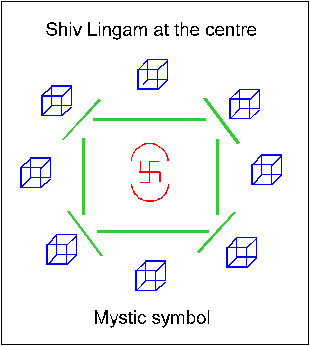
Sri Shiv Puran preserves the
enlightenment as that Shiv Lingam is to be installed at the centre of the mystic
symbol. The mystic symbol is the format of the Idol of Lord Brahma, the creator
the supreme. Shiv Lingam is the solid dimensional expression of the Shiv Lok
(5-space). The centre of the mystic symbol is the center of hypercube-4 / origin
of 4-space. The origin of 4-space is the seat of compactification of dimensional
spaces from 5-space onwards. The Shiv Lingam emerges from within the origin.
Source scripture:Sri Shiv Puran
Scripture Formats
26:
DESCRIPTION OF THE
WHEEL OF CAUSE BRAHMAN #1
Sawteshwara Upanishad describes
the wheel of cause Brahman as of 1 (Nemi), 3 (Vrit), 16 (Antah), 50 (Aras), 20
(Pratya), 6 (Ashtak), 1 (Pash, Vishwarupa), 3 (Marg), 2 (Paap, Punya) and 1
(Karan). The artifices of whole numbers availed in that sequence are: 1, 3, 16,
50, 20, 6, 1, 3, 2, 1.
Artifices of whole numbers 1 &
3:
One as 1-space in the role of
dimension creates 3-space.
Artifice of whole number 16:
The tri-monad, a monad of 3
parts, and an interval of 3 parts gives us 16 versions as:
(1) close interval when is
split into three parts, it gives us 4 versions as:
(a) close interval, open
interval, close interval
(b) close interval, half close
interval, half close interval
(c) half close interval, half
close interval, close interval
(d) half close interval, open
interval, close interval
(2) half-close interval (with
second end point missing) when is split into three parts, it gives us four
versions as:
(a) close interval, open
interval, half close interval
(b) half close interval, half
close interval, half close interval
(c) half close interval, close
interval, open interval
(d) close interval, half close
interval, open interval
(3) half-close interval (with
first end point missing) when is split into three parts, it gives us four
versions as:
(a) half close interval, open
interval, close interval
(b) half close interval, half
close interval, open interval
(c) open interval, close
interval, half close interval
(d) open interval, half close
interval, close interval
(4) open interval when is split
into three parts, it gives us four versions as:
(a) half close interval, open
interval, half close interval
(b) half close interval, half
close interval, open interval
(c) open interval, close
interval, open interval
(d) open interval, half close
interval, half close interval
Artifice of whole number 50:
3-space in the role of
dimension creates 5-space and as such 10×5=50 coordinates of solid dimensional
frame are required to fix the boundary of 5-space constituted by 10
hypercubes-4.
Artifice of whole number 20:
The domain-boundary fixation of
hypercube-5 can be had in terms of the artifice of whole number 20 which admits
arrangement and organization as 20=5×4.
Artifice of whole number 6:
The origin of hypercube-5 is
the seat of 6-space and as such origin of hypercube-5 admits fixation in terms
of the artifice of whole number 6.
Artifice of whole number 1, 3,
2 & 1:
The origin of origin of
hypercube-5 is the seat of 7-space. The artifices of whole numbers 1, 3, 2 & 1
together are the arrangement of the artifice of whole number 7. Going from the
artifice of 1 to the artifice of 3 is the going from dimension to domain and
going from 1 to 2 is going from the dimension to the boundary.
The above expression of the
wheel of "cause Brahman" takes us uptil the origin of the origin of the
transcendental world of 5-space.
Source scripture:Swateshwara Upanishad (Chapter 1 Mantra 4)
Scripture Formats
27:
DESCRIPTION OF THE
WHEEL OF CAUSE BRAHMAN #2
Sawteshwara Upanishad describes
the wheel of cause Brahman as of 1 (Nemi), 3 (Vrit), 16 (Antah), 50 (Aras), 20
(Pratya), 6 (Ashtak), 1 (Pash, Vishwarupa), 3 (Marg), 2 (Paap, Punya) and 1
(Karan). The artifices of whole numbers availed in that sequence are: 1, 3, 16,
50, 20, 6, 1, 3, 2, 1. In the reverse order the artifices of whole numbers give
us the sequence as 1, 2, 3, 1, 6, 20, 50, 16, 3, 1. This sequence admits
expression as: 1, 2, 3, 4=1, 4 leads to 6, 6 leads to 9+7+3+1, 4*5=20 leads to
5-space with 4-space boundary and 5*(1+2+3+4)=50 solid points fixation of
boundary, the tri-monad format of solids gives us 6-space at the centre of
5-space as 5+6+5=16 and 3 as tri-monad format and 1 as the linear order of
3-space.
On Om formulation, which is the
basic formulation for organization on 4-space format, sequentially the above
artifices of whole numbers leads to the following phases of organization of the
wheel of Cause Brahman.
The phase of artifices of whole
numbers 1, 2, 3, 4 and 1, 2, 3, 1 :-
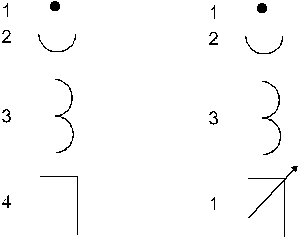
The phase of artifice of whole
numbers 6:
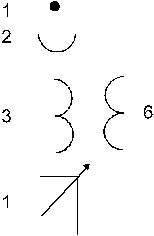
The phase of artifice of whole
number 20:
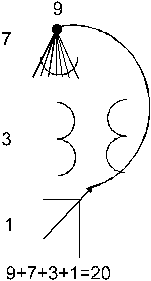
The phase of artifice of whole
number 50:
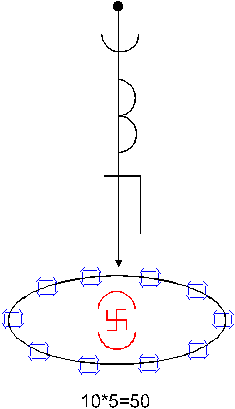
The phase of artifice of whole
number 16:-

The phase of artifice of whole
number 3:-

The phase of artifice of whole
number 1:-

Source scripture: Swateshwara Upanishad
Scripture Formats
28:
GORAKSHAKO
UPANISHAD (ENLIGHTENMENT OF PROTECTION OF ETERNAL GLOW) #1
Gorakshako Upanishad is the
source scripture of the Nath sect. Guru Gorakshanath, the incarnation of Lord
Shiv is the author of this scripture. This scripture is also known as Sidha
Sidhanta Padhati. This is a scripture of 6 Upadeshas (enlightenment). The
scripture range is of 353 Shalokas. The split up of this range is as of 73, 39,
13, 29, 84 and 115 Shalokas. The titles of the six Upadeshas are:
-
Pinda Utapatti
(73 Shalokas range): Pinda means body and Utapatti means emergence. As such the
simple English rendering for the title of first Upadesha is "Emergence of
Body". The enlightenment of this Upadesha is the enlightenment is the
emergence of human body. This enlightenment is organised on the geometric format
of 73 Shalokas range. The artifice of whole number 73 has been well utilised for
the organisation of this Upadesha
-
Pinda Vichaar
(39 Shalokas range): Pinda means body and Vichhar means the deep thought. As
such the simple English rendering for the title of second Upadesha is "Deep
thought about the body". This enlightenment is about the basic
characteristics of the geometric format for the life flow within the human body.
-
Pinda Samviti
(13 Shalokas range): Pinda means body and Samviti means knowledge. As such the
simple English rendering for the title of third Upadesha is "Knowledge of
human body". This enlightenment is about the basic knowledge of life within
the human body.
-
Pinda Adhara
(29 Shlokas range): Pinda means body and Ahdara means base. As such the simple
English rendering for the title of fourth Upadesha is "The ultimate base of
human body". This enlightenment is about the ultimate base of life within
the human body.
-
Samras Karanam
(84 Shlokas range): Sam means common, Ras means essence and Karanam means
ultimate sustenance. As such the simple English rendering for the title of fifth
Upadesha is "Common essence of the ultimate sustenance of life". This
enlightenment is about the common essence of the ultimate sustenance of life
within body
-
Avadhut Yogi Lakshanam
(115 Shalokas range): Avadhut Yogi means fully
elightened being and Lakshanam means characteristic features. As such the simple
English rendering for the title of sixth Upadesha is "The characteristics
features of fully enlightened being". This enlightenment takes us to the
common ultimate state of enlightenment for the living beings.
Scripture Formats
29:
GORAKSHAKO
UPANISHAD (ENLIGHTENMENT OF PROTECTION OF ETERNAL GLOW) #2
Guru Gorakhnath, the author of
the Upanishad is incarnation of Lord Shiv, the overlord of real 5-space.
Therefore, the basic format for the organisation of the scripture gets fixed as
of hypercube-5 / real 5-space.
Gorakshako Upanishadic text is
of 353 Shalokas range. The artifice of whole number 353 is unique in many ways
and it, in the light of the enlightenment of the scripture and the organisation
format beneath, helps us reach at the basic geometric lock of manifestation of
human body.
It is like the emergence of
real 5-space at the origin of affine 3-space. The origin of affine 3-space is
the seat of real 4-space and as such the transcendence and emergence at this
seat is there because of real 5-space being at the base of this seat. The real
5-space itself being a solid dimensional space, this (solid dimensional order)
as such locks the seat and the emerging geometric continuum locks the existence
phenomena.
This phenomenon of locking and
unlocking at the base of the origin of affine 3-space is the basic phenomenon
whose comprehension and chasing is to provide us the enlightenment of the
manifestation of human body and transcendence therefrom. This life phenomenon is
the phenomenon of eternal glow whose protection within the human body is the
subject matter of enlightenment of this Upanishad. One name for this discipline
may be the discipline of geometry of Vedic genetic engineering.
Scripture Formats
30:
GORAKSHAKO
UPANISHAD (ENLIGHTENMENT OF PROTECTION OF ETERNAL GLOW) #3
Guru Gorakhnath (Gorakshnath),
the author of the Upanishad, is the incarnation of Lord Shiv and with it the
basic format for organisation of the scripture is settled as hypercube-5 / real
5-space.
Om Namah Shivai
is the basic Mantra of enlightenment of Lord Shiv. Om
is sole-syllable, Namah is a pair of syllables and Shivai is a composition of
three syllables. With this, this is the enlightenment of artifices of whole
number 1, 2 & 3 and parallel to it 1-space, 2-space and 3-space and finally a
tri-monad format and so the solid dimensional order takes us to real 5-space.
The artifices of whole numbers
1, 2 & 3 together also give us 1+2+3 = 1×2×3 = 6. Simultaneously, we have 6
non-negative geometries of 5-space. This as such helps us to reach at the
organisation of the scripture as 6 Upadeshas parallel to the artifice of 6
supplied by the basic Mantra as well as the available 6 non-negative geometries
of 5-space.
Scripture Formats
31:
GORAKSHAKO
UPANISHAD (ENLIGHTENMENT OF PROTECTION OF ETERNAL GLOW) #4
The enlightenment of Gorakshako
Upanishad is the enlightenment of Shiv-lok and is the glow of Sri Shivpuran.
Sri Shivpuran preserves the
enlightenment as that the gods who were proud of their powers were made to
realise the limits of their powers by Lord Shiv as that they were even not
capable of making a split of even the blade of grass.
This is precisely the Shloka 26
of Chapter 16 of Satrudra Samhita and it reads as:
"If you are proud and think
that you know your strength to be great, O gods, split this blade of grass
placed by me, with your own weapons."
The geometric and algebraic
message here is that when we creates structures with the help of a binary
composition then the elements of the set at first operation give us the
composition elements of the form c=a×b. Then when further we operate such
composite elements and the resultant elements d = c1×c2
then d takes us uptil the boundary of a 3-space. The domain of 3-space remains
untouched though wrapped within the composed elements.
It is because of it that the
blade of grass as a solid remains un-split.
This enlightenment and message
deserves to be comprehended well to appreciate as to why our set theory approach
is creating mathematical knots and while we get dodged and feel as if we can
have space filling curves and why the situations like that of everywhere
continuous but nowhere differentiable functions and also the situations like the
hypercubes-8 onwards creating a decreasing value sequence at all arise for us
and we are not in a position even to logically catch as to why this all is
happening. This impossibility to split a blade of grass is the proposition and
situation at the base of Fermat's Last Theorem and similar like mathematical
problems of the day.
Scripture Formats
32:
GORAKSHAKO
UPANISHAD (ENLIGHTENMENT OF PROTECTION OF ETERNAL GLOW) #5
The organisation of the
Upanishad as 6 Upadeshas admits arrangement for its 353 Shalokas as 73, 39, 13,
29, 84 and 115. This arrangement is there because of the following format
beneath because of the geometries of 0, 1, 2, 3, 4 & 5. Here is drawn the
arrangement:
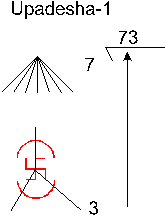
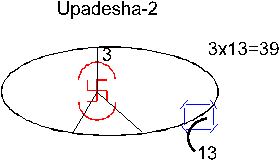
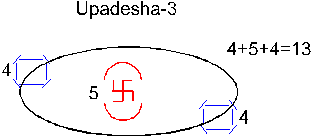
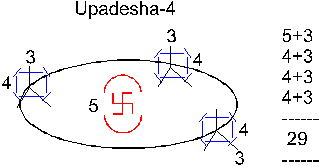
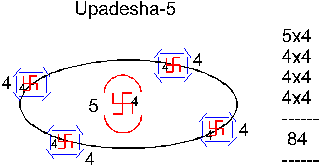
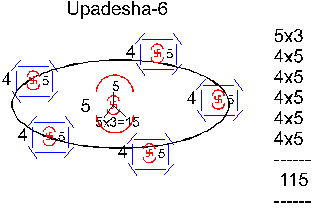
Scripture Formats
33:
GORAKSHAKO
UPANISHAD (ENLIGHTENMENT OF PROTECTION OF ETERNAL GLOW) #6 :
SELF-REFERRAL STATE
Sri Shivpuran Samhita preserves the enlightenment that when Lord Brahma (the
presiding deity of 4-space) and Lord Vishnu (the presiding deity of 6-space) are
face to face and are interacting to know the Brahman, there emerges Lord Shiv
(the presiding deity of 5-space) in between them as an infinite pillar of fire
(Agani Tatva; the third basic element with Prithvi (earth) as first and Jal
(water) as the second).
The geometric message of this
enlightenment is that when we are in a Creator's space (the spatial order
space), 4-space plays the role of dimension for 6-space as domain and the place
for the boundary is in between them and it is played by 5-space. The boundary
which envelops within itself the domain is zero as far as the domain grains are
concerned. This role of boundary to be zero qua the domain grains is there
through out and it is so as within spatial order, 1-space admits -1 space as its
dimension and 0-space iin the role of the boundary with 2-space as the origin.
This organisation because of
2-space in the role of origin gives us the arrangement because of which there
emerges splitting of the positive and negative orientation of 1-space and hence
of the interval, and as of the infinite line. This splitting of the orientations
as positive and negative orientations makes them as absolutely different worlds
as much as that the positive orientations takes us to +1 space and the negative
orientations takes us to -1 space. With this, there automatically emerges a jump
over a 0-space. In other words, 0-space marks its presence of its own and its
emergence is spontaneous and is always there even if remains latent in between
the positive and negative orientations. This is the self-referral state. The
positive orientations as 1-space and further in the role of dimension of 3-space
gives us as many as 7 geometries for 3-space. Likewise the change of orientation
would take us from -1 space to -3 space but in a reverse order as much as that
-1 space would become the domain and -33 space as the dimension. The 7
geometries here for -3 space and then the continuity from -3 space to +3 space
with 0-space in between -1 space and +1 space gives us two parallel set ups like
the pair of objects with their reflection images and because of it a
self-referral state makes it possible to have self-evaluation and self-appraisal
of one's knowledge and it is there at the format of the division of the brain
within human heads as of left and right parts.
The enlightenment of Sri
Shivpuran from the stage of emergence of Lord Shiv as infinite pillar of fire in
between Lord Brahma and Lord Vishnu goes further as that both Lord Brahma and
Lord Vishnu interacted and asked as to what this form is there and when both
showed ignorance about it to each other they decided as that one should go
upward and try to know uptil which the pillar takes and the other should go
downward and try to know uptil what it takes to. Both had tried and realized
that it was not possible to scale the pillar.
This enlightenment made them
realized the transcendental state of Lord Shiv (the presiding deity of real
5-space) and both of them attained self-referral state and ultimately the
transcendental state and realized that it was not sufficient only to go upward
and the going upward and going downward were two different organizations and
arrangements and those can be known only with reference to the orientation free
state of 0-space emerging between the positive and negative orientations spaces.